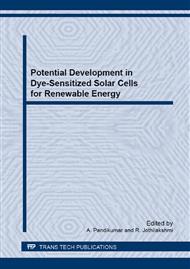[1]
K. Hara, H. Arakawa, Dye-Sensitized Solar Cells, in: A. Luque, S. Hegedus (Eds.), Handbook of Photovoltaic Science and Engineering, John Wiley & Sons ltd., New York, (2003) 663-700.
DOI: 10.1002/0470014008.ch15
Google Scholar
[2]
Md. K. Nazeeruddin, A.Kay, I.Rodicio, R. Humphry-Baker, E. Müller, P. Liska, N. Vlachopoulos, M. Grätzel, Conversion of Light to Electricity by cis-X2Bis (2,2' bipyridl- 4,4' dicarboxylate) Ruthenium (II) Charge-Transfer Sensitzers (X= Cl- , Br- , I- , CN- and SCN-) on Nanocrystalline TiO2 Electrodes, J. Am. Chem. Soc. 115 (1993) 6382-6390.
DOI: 10.1021/ja00067a063
Google Scholar
[3]
B. O'Regan, M. Grätzel, A low-cost, high-efficiency solar cell based on dye-sensitized colloidal TiO2 films, Nature 353 (1991) 737-740.
DOI: 10.1038/353737a0
Google Scholar
[4]
Md. K. Nazeeruddin, P. Pèchy, M. Grätzel, Efficient panchromatic sensitization of nanocrystalline TiO2 films by a black dye based on atrithiocyanato–ruthenium complex, Chem. Commun. (1997) 1705-1706.
DOI: 10.1039/a703277c
Google Scholar
[5]
Md. K. Nazeeruddin, P. Pèchy, T. Renouard, Shaikh M. Zakeeruddin, R. Humphry-Baker, P. Comte, P. Liska, Le Cevey, E. Costa, V. Shklover, L. Spiccia, G.B. Deacon, C.A. Bignozzi, M. Grätzel, Engineering of Efficient Panchromatic Sensitizers for Nanocrystalline TiO2-Based Solar Cells, J. Am. Chem. Soc. 123 (2001) 1613-1624.
DOI: 10.1021/ja003299u
Google Scholar
[6]
l earning from nature: dye sensitized solar cells: By Kathy Li Dessau 2nd November 2010, Information on: http://www.solarnovus.com
Google Scholar
[7]
A. Janotti, C.G. Van de Walle, Fundamentals of Zinc Oxide as a Semi-Conductor, Rep. prog. Phys. 72 (2009) 1-29
Google Scholar
[8]
K.D. Benkstein, N. Kopidakis, J.V. Lagemaat and A.J. Frank, Influence of the percolation network geometry on electron transport in dye-sensitized titanium dioxide solar cells, J. Phys. Chem. B, 107 (31) (2003) 7759–7767.
DOI: 10.1021/jp022681l
Google Scholar
[9]
M. Grätzel, Perspectives for dye-sensitized nanocrystalline solar cells, Prog. Photovolt. Res. Appl., 8 (1) (2000) 27-38.
Google Scholar
[10]
A. P. Uthirakumar, Fabrication of ZnO Based Dye Sensitized Solar Cells, in: L.A. Kosyachenko (Eds.), Solar Cells-Dye-Sensitized Devices, InTech, Europe ( 2011) 435- 456.
DOI: 10.5772/19459
Google Scholar
[11]
E. A. Meulenkamp, Synthesis and growth of ZnO nanoparticles, J. Phys. Chem. B., 102 (1998) 5566-5572.
Google Scholar
[12]
B. Postels, A. Kasprzak, T. Buergel, A. Bakin, E. Schlenker, H.H. Wehmann, A. Waag, Dye-sSensitized solar cells on the basis of ZnO nanorods, J. Kor. Phys. Soc., 53 (2008) 115- 118.
DOI: 10.3938/jkps.53.115
Google Scholar
[13]
M. Law, L.E. Greene, J.C. Johnson, R. Saykally, P. Yang, Nanowire dye-sensitized solar cells, Nat. Mat., 4 (2005) 455-459.
DOI: 10.1038/nmat1387
Google Scholar
[14]
Q. Zhang, C.S. Dandeneau, X. Zhou, G. Cao, ZnO Nanostructures for dye-sensitized solar cells, Adv. Mater., 21 (2009) 4087-4108.
DOI: 10.1002/adma.200803827
Google Scholar
[15]
C. Y. Jiang, X. W. Sun, G.Q. Lo, D. L. Kwong, Improved Dye-Sensitized Solar Cells with a ZnO-nanoflower Photoanode, Appl. Phys. Lett., 90 (2007) 263501.
DOI: 10.1063/1.2751588
Google Scholar
[16]
S.H. Ko, D. Lee, H.W. Kang, K.H. Nam, J.Y. Yeo, S.J. Hong, C.P. Grigoropoulos, H.J. Sung, Nanoforest of Hydrothermally Grown Hierarchical ZnO Nanowires for a High Efficiency Dye-Sensitized Solar Cell, Nano Lett., 11 (2011) 666-671.
DOI: 10.1021/nl1037962
Google Scholar
[17]
J. B. Baxter, E. S. Aydil, Nanowire-based dye-sensitized solar cells, Appl. Phys. Lett., 86 (2005) 053114.
DOI: 10.1063/1.1861510
Google Scholar
[18]
A. B. F. Martinson, J. E. McGarrah, Md. O. K. Parpia, J. T. Hupp, Dynamics of charge transport and recombination in ZnO nanorod array Dye-Sensitized Solar Cells, Phys. Chem. Chem. Phys., 8 (2006) 4655-4659.
DOI: 10.1039/b610566a
Google Scholar
[19]
H. Horiuchi, R. Katoh, K. Hara, M. Yanagida, S. Murata, H. Arakawa, M. Tachiya, Electron Injection Efficiency from Excited N3 into Nanocrystalline ZnO Films: Effect of (N3-Zn2+) Aggregate Formation, J. Phys. Chem. B, 107 (2003) 2570-2574.
DOI: 10.1021/jp0220027
Google Scholar
[20]
K. Westermark, H. Rensmo, H. Siegbahn, K. Keis, A. Hagfeldt, L. Ojamae, P. Persson, PES Studies of Ru(dcbpyH2)2(NCS)2 Adsorption on Nanostructured ZnO for Solar Cell Applications, J. Phys. Chem. B, 106 (2002) 10102-10107.
DOI: 10.1021/jp0142177
Google Scholar
[21]
T. P. Chou, Q. F. Zhang, G. Z. Cao, Effect of Dye Loading Conditions on the Energy Conversion Efficiency of ZnO and TiO2 Dye-Sensitized Solar Cells, J. Phys. Chem. C, 111 (2007) 18804-18811 .
DOI: 10.1021/jp076724f
Google Scholar
[22]
N. A. Anderson, X. Ai, T. Q. Lian, Electron Injection Dynamics from Ru Polypyridyl complexes to ZnO Nanocrystalline Thin Films, J. Phys. Chem. B, 107 (2003) 14414-14421.
DOI: 10.1021/jp036201h
Google Scholar
[23]
J. B. Asbury, E. Hao, Y. Q. Wang, H. N. Ghosh, T. Q. Lian, Ultrafast Electron Transfer Dynamics from Molecular Adsorbates to Semiconductor Nanocrystalline Thin Films, J. Phys. Chem. B, 105 (2001) 4545-4557.
DOI: 10.1021/jp003485m
Google Scholar
[24]
J. B. Asbury, N. A. Anderson, E. C. Hao, X. Ai, T. Q. Lian, Parameters Affecting Electron Injection Dynamics from Ruthenium Dyes to Titanium Dioxide Nanocrystalline Thin Film, J. Phys. Chem. B, 107 (2003) 7376-7386.
DOI: 10.1021/jp034148r
Google Scholar
[25]
D. Kuciauskas, J. E. Monat, R. Villahermosa, H. B. Gray, N. S. Lewis, J. K. McCusker, Transient Absorption Spectroscopy of Ruthenium and Osmium Polypyridyl complexed adsorbed onto Nanocrystalline TiO2 photoelectrodes, J. Phys. Chem. B, 106 (2002) 9347- 9358.
DOI: 10.1021/jp014589f
Google Scholar
[26]
G. Benko, J. Kallioinen, J. E. I. Korppi-Tommola, A. P. Yartsev, V. Sundstrom, Photoinduced Ultrafast Dye-to-Semiconductor Electron Injection from Nonthermalized and Thermalized Donor States, J. Am. Chem. Soc., 124 (2002) 489-493.
DOI: 10.1021/ja016561n
Google Scholar
[27]
J. B. Asbury, Y. Q. Wang, T. Q. Lian, Multiple-Exponential Electron Injection in Ru(dcbpy)2(SCN)2 Sensitized ZnO Nanocrystalline thin films, J. Phys. Chem. B, 103 (1999) 6643-6647.
DOI: 10.1021/jp991625q
Google Scholar
[28]
N. A. Anderson, T. Lian, Ultrafast Electron Injection from Metal Polypyridyl Complexes to Metal-Oxide Nanocrystalline thin films, Coord. Chem. Rev., 248 (2004) 1231-1246.
DOI: 10.1016/j.ccr.2004.03.029
Google Scholar
[29]
B. Enright, D. Fitzmaurice, Spectroscopic Determination of Electron and Hole Effective Masses in a Nanocrystalline Semiconductor Film, J. Phys. Chem., 100 (1996) 1027-1035.
DOI: 10.1021/jp951142w
Google Scholar
[30]
A. Furube, R. Katoh, K. Hara, S. Murata, H. Arakawa, M. Tachiya, Ultrafast Stepwise Electron Injection from Photoexcited Ru-Complex into Nanocrystalline ZnO Film via Intermediates at the surface, J. Phys. Chem. B, 107 (2003) 4162-4166.
DOI: 10.1021/jp034039c
Google Scholar



